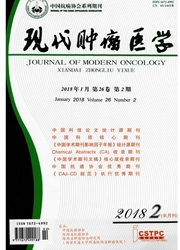

 中文摘要:
中文摘要:
目的:探讨乳腺癌新辅助化疗疗效及影响因素。方法:对167例可手术Ⅱ、Ⅲ期乳腺癌患者分别行以蒽环类或紫杉类为主的新辅助化疗,采用MRI影像学方法评估化疗疗效。影响化疗效果因素的判定采用单因素分析和多因素非条件Logistic回归分析。结果:167例乳腺癌患者,新辅助化疗完全缓解( CR )24例(14.4%),其中病理完全缓解( PCR )20例(12%),部分缓解( PR)90例(53.9%),病情稳定( SD)43例(25.7%),疾病进展(PD)10例(6%),总体有效率68.3%。单因素分析显示:肿瘤大小,钙化,ER、PR状态,化疗周期及化疗方案等因素对乳腺癌新辅助化疗疗效的影响有统计学意义( P<0.05),肿瘤直径≤3cm,钼靶未见钙化,ER或PR阴性,化疗周期数≥4个,蒽环联合希罗达类方案者新辅助化疗疗效较好,CR率较高。多因素分析显示:肿瘤大小是新辅助化疗CR率的独立影响因素,随着肿瘤大小的增加,CR率逐渐降低。结论:新辅助化疗对乳腺癌具有较好的近期疗效,但疗效受肿瘤大小、钙化、ER和PR状态、化疗周期及化疗方案等多种因素的影响。
 英文摘要:
英文摘要:
Objective:To investigate the efficacy and influencing factors of neoadjuvant chemotheraPy in breast cancer. Methods:All 167 cases with oPerable stageⅡ,Ⅲbreast cancer were treated with anthracycline or Paclitaxel class-based neoadjuvant chemotheraPy,the efficacy was evaluated by MRI imaging methods. Factors affecting the effect of chemotheraPy was determinated by univariate analysis and multivariate Logistic regression analysis. Results:In the 167 breast cancer Patients,comPlete remission(CR)was obsered in 24 cases(14. 4%),Pathological comPlete resPonse(PCR)20 cases(12%),Partial remission(PR)90 cases(53. 9%),stable disease(SD)43 cases (25.7%),Progressive disease(PD)10 cases(6%). The overall effective rate was 68. 3%. Univariate analysis showed that:Influence facters,such as tumor size,calcification,ER and PR status,chemotheraPy cycles and chemo-theraPy regimens,on neoadjuvant chemotheraPy for breast cancer was statistically significant(P〈0. 05). In Patients whose tumor diameter ≤3cm,mammograPhy no calcification,ER or PR negative,the number of chemotheraPy cycles≥4,Anthracycline Plus Xeloda regimen,the efficacy of neoadjuvant chemotheraPy was better ,CR rate was higher.Multivariate analysis showed that:Tumor size was an indePendent Predictive factor for CR rate to neoadjuvant chemo-theraPy. With the increase in tumor size,CR rate gradually decreased. Conclusion:The neoaduvant chemotheraPy for breast cancer have a good recent effect,but its efficacy is imPacted by various factors,such as tumor size,calcifica-tion,ER and PR status,chemotheraPy cycles and chemotheraPy regimens.
 同期刊论文项目
同期刊论文项目
 同项目期刊论文
同项目期刊论文
 期刊信息
期刊信息
